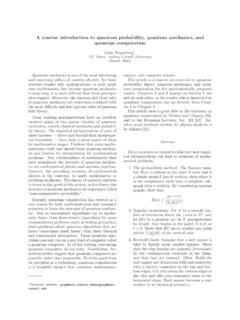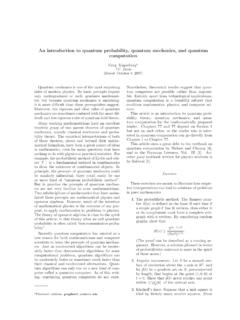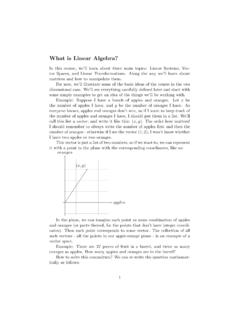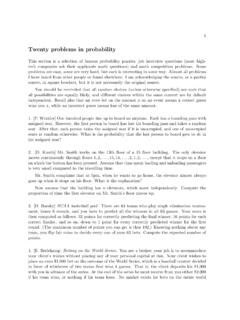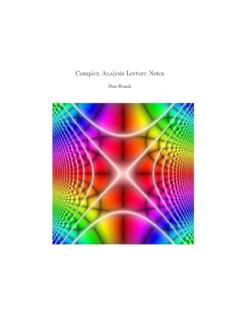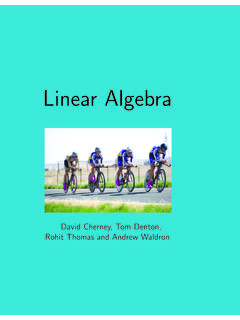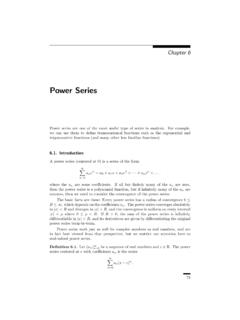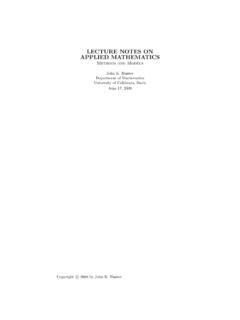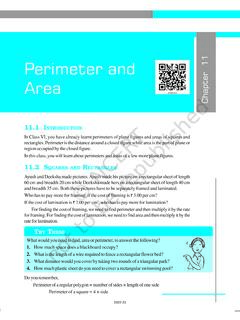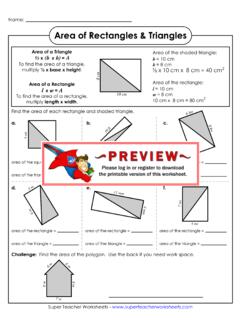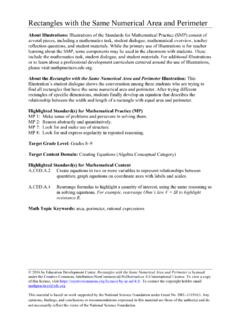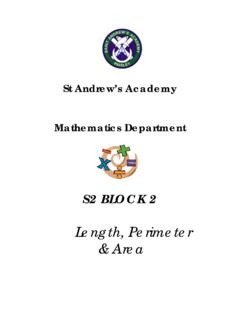Transcription of The Riemann Integral - University of California, Davis
1 Chapter 1 The Riemann IntegralI know of some universities in England where the Lebesgue Integral istaughtin the first year of a mathematics degree instead of the Riemannintegral, but I know of no universities in England where studentslearnthe Lebesgue Integral in the first year of a mathematics degree. (Ap-proximate quotation attributed to T. W. K orner)Letf: [a, b] Rbe a bounded (not necessarily continuous) function on acompact (closed, bounded) interval. We will define what it means forfto beRiemann integrable on [a, b] and, in that case, define its Riemann Integral offon [a, b] is a real number whose geometrical interpretation is thesigned area under the graphy=f(x) fora x b.
2 This number is also calledthe definite Integral off. By integratingfover an interval [a, x] with varying rightend-point, we get a function ofx, called the indefinite Integral most important result about integration is the fundamental theorem ofcalculus, which states that integration and differentiation are inverse operations inan appropriately understood sense. Among other things, this connection enablesus to compute many integrals is a less restrictive condition on a function than differentiabil-ity. Roughly speaking, integration makes functions smoother, whiledifferentiationmakes functions rougher.
3 For example, the indefinite Integral of every continuousfunction exists and is differentiable, whereas the derivative of a continuous functionneed not exist (and generally doesn t).The Riemann Integral is the simplest Integral to define, and it allows one tointegrate every continuous function as well as some not-too-badly discontinuousfunctions. There are, however, many other types of integrals, the most importantof which is the Lebesgue Integral . The Lebesgue Integral allows one to integrateunbounded or highly discontinuous functions whose Riemann integrals do not exist,and it has better mathematical properties than the Riemann Integral .
4 The defini-tion of the Lebesgue Integral requires the use of measure theory, which we will not121. The Riemann Integraldescribe here. In any event, the Riemann Integral is adequate formany purposes,and even if one needs the Lebesgue Integral , it s better to understand the Riemannintegral Definition of the Riemann integralWe say that two intervals are almost disjoint if they are disjoint or intersect only ata common endpoint. For example, the intervals [0,1] and [1,3] are almost disjoint,whereas the intervals [0,2] and [1,3] are a nonempty, compact interval. A partition ofIis a finitecollection{I1, I2.}
5 , In}of almost disjoint, nonempty, compact subintervals whoseunion partition of [a, b] with subintervalsIk= [xk 1, xk] is determined by the setof endpoints of the intervalsa=x0< x1< x2< < xn 1< xn= notation, we will denote a partitionPeither by its intervalsP={I1, I2, .. , In}or by the set of endpoints of the intervalsP={x0, x1, x2, .. , xn 1, xn}.We ll adopt either notation as convenient; the context should makeit clear whichone is being used. There is always one more endpoint than set of intervals{[0,1/5],[1/5,1/4],[1/4,1/3],[1 /3,1/2],[1/2,1]}is a partition of [0,1].
6 The corresponding set of endpoints is{0,1/5,1/4,1/3,1/2,1}.We denote the length of an intervalI= [a, b] by|I|=b that the sum of the lengths|Ik|=xk xk 1of the almost disjoint subintervalsin a partition{I1, I2, .. , In}of an intervalIis equal to length of the whole is obvious geometrically; algebraically, it follows from the telescoping seriesnXk=1|Ik|=nXk=1(xk xk 1)=xn xn 1+xn 1 xn 2+ +x2 x1+x1 x0=xn x0=|I|.Suppose thatf: [a, b] Ris a bounded function on the compact intervalI= [a, b] withM= supIf,m= Definition of the Riemann integral3 IfP={I1, I2, .. , In}is a partition ofI, letMk= supIkf,mk= suprema and infima are well-defined, finite real numbers sincefis ,m mk Mk continuous on the intervalI, then it is bounded and attains its maximumand minimum values on each subinterval, but a bounded discontinuousfunctionneed not attain its supremum or define the upper Riemann sum offwith respect to the partitionPbyU(f;P) =nXk=1Mk|Ik|=nXk=1Mk(xk xk 1),and the lower Riemann sum offwith respect to the partitionPbyL(f;P) =nXk=1mk|Ik|=nXk=1mk(xk xk 1).
7 Geometrically,U(f;P) is the sum of the areas of rectangles based on the intervalsIkthat lie above the graph off, andL(f;P) is the sum of the areas of rectanglesthat lie below the graph off. Note thatm(b a) L(f;P) U(f;P) M(b a).Let (a, b), or for short, denote the collection of all partitions of [a, b]. Wedefine the upper Riemann Integral offon [a, b] byU(f) = infP U(f;P).The set{U(f;P) :P }of all upper Riemann sums offis bounded frombelow bym(b a), so this infimum is well-defined and finite. Similarly, the set{L(f;P) :P }of all lower Riemann sums is bounded from above byM(b a),and we define the lower Riemann Integral offon [a, b] byL(f) = supP L(f;P).
8 These upper and lower sums and integrals depend on the interval [a, b] as well as thefunctionf, but to simplify the notation we won t show this explicitly. A commonlyused alternative notation for the upper and lower integrals isU(f) =Zbaf,L(f) = the use of lower-upper and upper-lower approximationsfor the inte-grals: we take the infimum of the upper sums and the supremum of the lower we show in Proposition below, we always haveL(f) U(f), but in generalthe upper and lower integrals need not be equal. We define Riemann integrabilityby their The Riemann IntegralDefinition bounded functionf: [a, b] Ris Riemann integrable on [a, b]if its upper integralU(f) and lower integralL(f) are equal.
9 In that case, theRiemann Integral offon [a, b], denoted byZbaf(x)dx,Zbaf,Z[a,b]for similar notations, is the common value ofU(f) andL(f).An unbounded function is not Riemann integrable. In the following, inte-grable will mean Riemann integrable, and Integral will mean Riemann inte-gral unless stated explicitly Examples of the Riemann integralLet us illustrate the definition of Riemann integrability with a number : [0,1] Rbyf(x) =(1/xif 0< x 1,0ifx= t defined as a Riemann Integral becuasefis unbounded. In fact, if0< x1< x2< < xn 1<1is a partition of [0,1], thensup[0,x1]f= ,so the upper Riemann sums offare not Integral with an unbounded interval of integration, such asZ 11xdx,also isn t defined as a Riemann Integral .)
10 In this case, a partition of [1, ) intofinitely many intervals contains at least one unbounded interval, so the correspond-ing Riemann sum is not well-defined. A partition of [1, ) into bounded intervals(for example,Ik= [k, k+ 1] withk N) gives an infinite series rather than a finiteRiemann sum, leading to questions of can interpret the integrals in this example as limits of Riemann integrals,or improper Riemann integrals,Z101xdx= lim 0+Z1 1xdx,Z 11xdx= limr Zr11xdx,but these are not proper Riemann integrals in the sense of Suchimproper Riemann integrals involve two limits a limit of Riemann sums to de-fine the Riemann integrals, followed by a limit of Riemann integrals.]]

